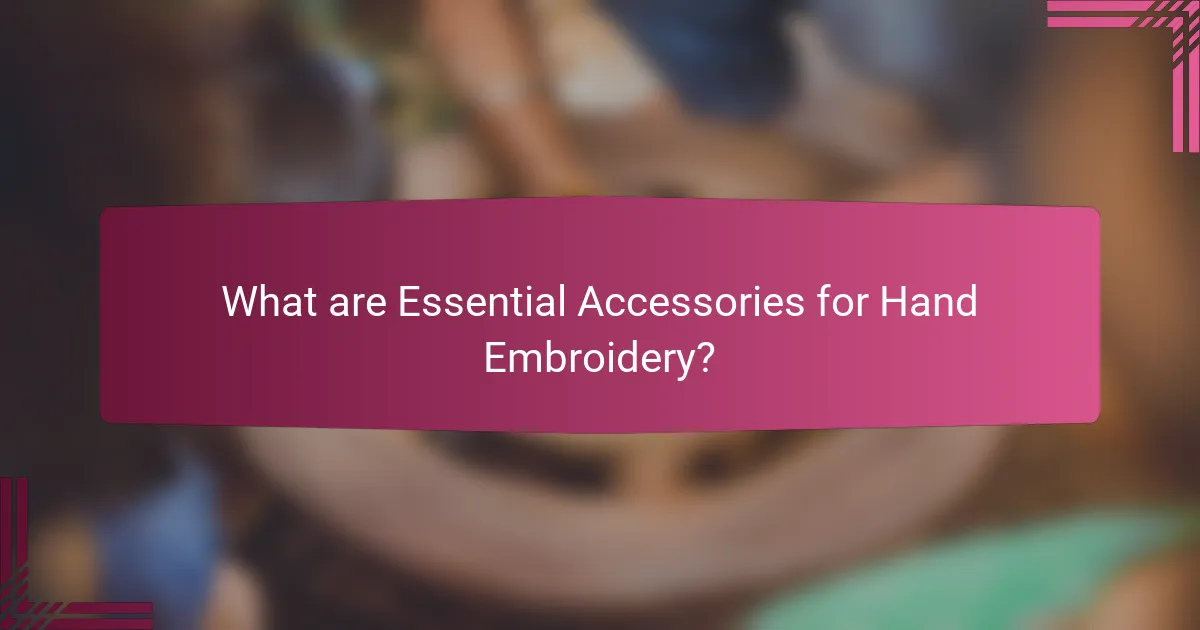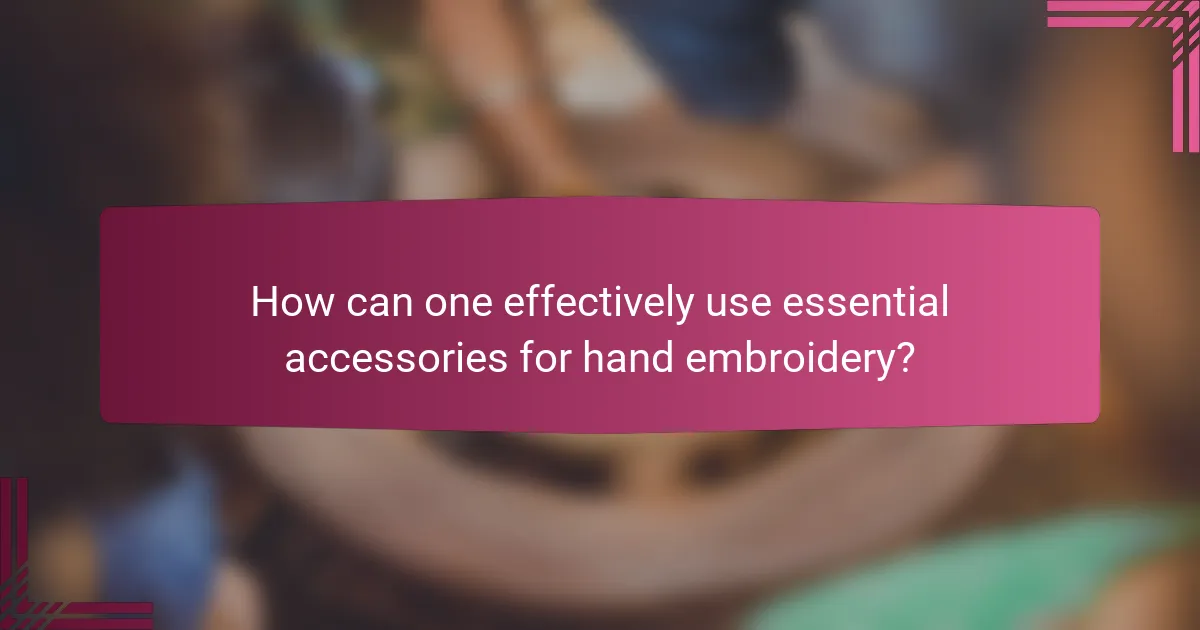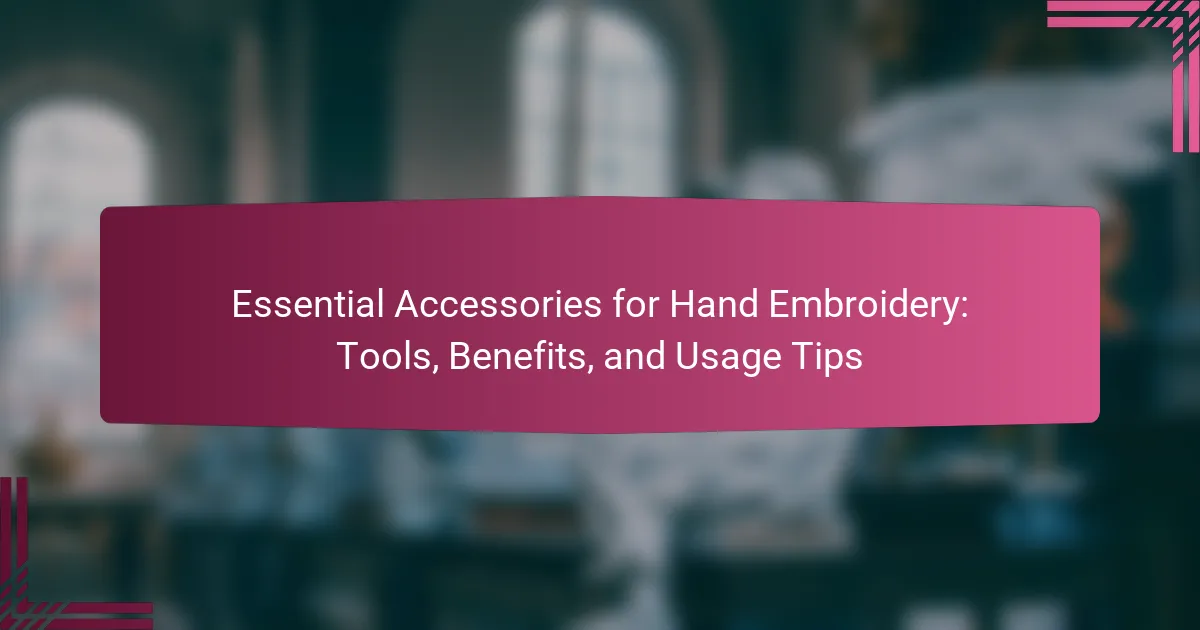
What are Essential Accessories for Hand Embroidery?
Essential accessories for hand embroidery include embroidery hoops, needles, thread, scissors, and fabric. Embroidery hoops hold the fabric taut while stitching. Needles come in various sizes for different thread types and fabric weights. Quality thread ensures durability and colorfastness. Scissors are necessary for precise cutting of threads and fabric. Fabric choice affects the overall appearance of the embroidery. These tools are fundamental for achieving clean and professional results in hand embroidery.
What tools are considered essential for hand embroidery?
Essential tools for hand embroidery include embroidery needles, embroidery floss, fabric, embroidery hoops, and scissors. Embroidery needles have a larger eye to accommodate multiple strands of thread. Embroidery floss is a six-strand thread that can be separated for varying thicknesses. Fabric must be suitable for embroidery, such as cotton or linen. Embroidery hoops keep the fabric taut while working. Scissors are necessary for trimming threads and finishing projects. These tools are fundamental for achieving quality results in hand embroidery.
How do these tools enhance the embroidery process?
Embroidery tools enhance the embroidery process by improving efficiency and precision. Tools such as embroidery hoops stabilize fabric, preventing distortion during stitching. Scissors designed for embroidery provide clean cuts, reducing fraying and ensuring neat edges. Needles with specific sizes and types allow for smoother stitching on various fabrics. Marking tools help in transferring designs accurately, ensuring alignment and consistency. Threaders simplify the threading process, saving time and reducing frustration. Finally, storage solutions keep tools organized, making them easily accessible during projects. These enhancements lead to higher quality results and a more enjoyable embroidery experience.
What are the different types of needles used in hand embroidery?
The different types of needles used in hand embroidery include embroidery needles, crewel needles, and tapestry needles. Embroidery needles have a sharp point and a larger eye for various threads. They are ideal for general embroidery work. Crewel needles are similar but have a longer eye, suitable for thicker threads. Tapestry needles feature a blunt tip and a large eye, perfect for working with multiple strands of yarn. Each needle type is designed for specific thread and fabric combinations. Using the correct needle ensures better results and reduces fabric damage.
What benefits do essential accessories provide for hand embroidery?
Essential accessories enhance hand embroidery by improving precision and efficiency. Tools like embroidery hoops stabilize fabric, preventing distortion during stitching. Scissors designed for embroidery allow for clean cuts, reducing fraying. Needles with specific sizes and types ensure proper thread handling and minimize fabric damage. Threaders simplify the process of threading needles, saving time. Marking tools help in accurate design placement, which enhances overall quality. These accessories collectively contribute to a smoother, more enjoyable embroidery experience.
How do these accessories improve the quality of the finished work?
Accessories for hand embroidery enhance the quality of the finished work by providing precision and ease of use. Tools like embroidery hoops stabilize fabric, preventing distortion during stitching. Quality needles facilitate smoother threading and reduce fabric snagging. Scissors designed for embroidery allow for clean, precise cuts, ensuring neat edges. Marking tools help in accurately transferring designs, leading to more professional results. Additionally, proper lighting improves visibility, reducing eye strain and mistakes. Each of these accessories contributes to a more polished and refined final product.
What role do accessories play in the efficiency of the embroidery process?
Accessories play a crucial role in the efficiency of the embroidery process. They enhance precision and speed during stitching. For instance, tools like embroidery hoops stabilize fabric, preventing shifting. This stability allows for consistent stitch placement. Additionally, specialized needles reduce thread breakage and improve the quality of stitches. Scissors designed for embroidery provide clean cuts, minimizing fraying. Thread organizers help maintain order, reducing time spent searching for supplies. Overall, the right accessories streamline the workflow, making the embroidery process more effective and enjoyable.

How can one effectively use essential accessories for hand embroidery?
To effectively use essential accessories for hand embroidery, one should select the right tools. Key accessories include embroidery hoops, needles, threads, and scissors. Embroidery hoops keep fabric taut, preventing distortion. Needles should match the thread thickness and fabric type for smooth stitching. High-quality threads reduce tangling and fraying during use. Sharp scissors are essential for clean thread cuts and finishing touches. Organizing accessories in a dedicated space enhances accessibility and efficiency. Proper maintenance of tools, such as cleaning needles and storing threads properly, prolongs their lifespan. Using these accessories correctly improves the overall quality of hand embroidery projects.
What are the best practices for using embroidery tools?
To use embroidery tools effectively, start by selecting the right tool for your project. Use sharp needles that match your fabric type for clean stitching. Keep your tools organized to avoid loss and damage. Regularly clean your tools to maintain their functionality. Store threads away from direct sunlight to prevent fading. Practice proper tension to ensure even stitches and avoid puckering. Follow manufacturer instructions for tool usage to maximize performance. These practices enhance the quality of your embroidery work.
How should one care for and maintain embroidery tools?
To care for and maintain embroidery tools, regularly clean them after each use. Use a soft cloth to wipe down scissors, needles, and hoops. Store tools in a dry, organized space to prevent rust and damage. Ensure scissors are sharpened to maintain cutting efficiency. Check needles for bends or breaks before use. For fabric markers, cap them tightly to prevent drying out. Regular maintenance extends the life of embroidery tools and ensures optimal performance. Proper care prevents costly replacements and enhances the quality of embroidery projects.
What techniques can improve the use of essential accessories?
Utilizing essential accessories for hand embroidery can be improved through organization, proper technique, and regular maintenance. Organizing tools like needles, threads, and hoops enhances efficiency. Using a needle threader can simplify the threading process. Employing a hoop ensures consistent tension on the fabric, resulting in even stitches. Regularly cleaning and oiling sewing machines and tools extends their lifespan. Additionally, practicing different stitching techniques can enhance skill and creativity. Following these techniques can lead to a more enjoyable and productive embroidery experience.
What common mistakes should be avoided when using embroidery accessories?
Common mistakes to avoid when using embroidery accessories include using the wrong needle type. Each fabric requires a specific needle to prevent damage. Another mistake is not using the correct thread weight. Mismatched thread can lead to tension issues. Failing to properly secure fabric in the hoop is also common. This can cause uneven stitching and puckering. Additionally, neglecting to clean tools regularly can affect performance. Dust and debris can hinder the stitching process. Lastly, not reading instructions for accessories can result in improper use. Following guidelines ensures optimal results.
How can improper use of tools affect the outcome of embroidery projects?
Improper use of tools can lead to subpar embroidery outcomes. Using the wrong needle can cause fabric damage or uneven stitches. Incorrect thread tension can result in puckering or loose threads. Poorly maintained tools may lead to skipped stitches or fraying. Inadequate lighting can hinder precision, causing mistakes in design placement. Additionally, using the wrong type of scissors can affect thread cutting accuracy. Each of these factors can compromise the overall quality of the embroidery project.

What additional insights can enhance the hand embroidery experience?
Using high-quality materials can enhance the hand embroidery experience. Premium threads and fabrics improve the final appearance and durability of the work. Proper lighting is crucial for reducing eye strain during detailed stitching. An ergonomic workspace can prevent discomfort and fatigue. Joining embroidery communities provides support and inspiration. Learning new techniques expands creative possibilities. Utilizing digital resources, such as tutorials, offers guidance for skill improvement. Regular practice enhances proficiency and confidence in hand embroidery.
What tips can help beginners get started with hand embroidery accessories?
Beginners can start with hand embroidery accessories by selecting essential tools. Key tools include embroidery hoops, needles, and thread. Choose a hoop that fits your fabric size. Use sharp needles designed for embroidery to avoid fabric damage. Select high-quality embroidery thread for better results. Start with simple patterns to build confidence. Practice basic stitches like backstitch and satin stitch. Organize your workspace for easy access to tools. Finally, watch tutorials to enhance your skills and techniques.
How can one choose the right accessories based on project needs?
To choose the right accessories for hand embroidery projects, assess the specific requirements of the project. Identify the fabric type, thread count, and design complexity. Select tools that match these criteria, such as needles, hoops, and scissors. For intricate designs, finer needles and smaller hoops are beneficial. For larger projects, consider larger hoops for better tension. Evaluate the thread type needed, as cotton, silk, or specialty threads serve different purposes. Ensure that the accessories are compatible with the chosen fabric to avoid damage. Finally, consult guidelines or recommendations from experienced embroiderers for best practices in accessory selection.
What troubleshooting advice is available for common issues with embroidery tools?
Common issues with embroidery tools often include thread breakage, needle problems, and tension issues. For thread breakage, ensure the thread is correctly threaded through the machine and that the spool is not tangled. Check for any burrs on the needle or the machine that could snag the thread. If the needle is dull or bent, replace it with a new one appropriate for the fabric type.
Tension issues can arise from incorrect settings on the machine. Adjust the upper and lower tension settings according to the thread and fabric used. If stitches are uneven, rethread the machine and check for proper bobbin placement.
Cleaning the machine regularly can also prevent many common issues. Dust and lint buildup can affect performance. Following these troubleshooting steps can help maintain the functionality of embroidery tools effectively.
Essential accessories for hand embroidery encompass tools such as embroidery hoops, needles, thread, scissors, and fabric, each playing a crucial role in achieving quality results. The article details the function of these tools, their benefits, and best practices for usage and maintenance, emphasizing how they enhance precision and efficiency in the embroidery process. It also covers common mistakes to avoid and troubleshooting advice for common issues, ensuring that users can effectively select and utilize the right accessories for their projects. Additionally, insights for beginners and techniques to improve the embroidery experience are provided, making this a comprehensive guide for both novice and experienced embroiderers.
